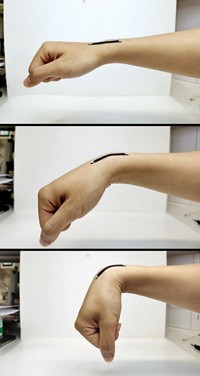Advertisement
Grab your lab coat. Let's get started
Welcome!
Welcome!
Create an account below to get 6 C&EN articles per month, receive newsletters and more - all free.
It seems this is your first time logging in online. Please enter the following information to continue.
As an ACS member you automatically get access to this site. All we need is few more details to create your reading experience.
Not you? Sign in with a different account.
Not you? Sign in with a different account.
ERROR 1
ERROR 1
ERROR 2
ERROR 2
ERROR 2
ERROR 2
ERROR 2
Password and Confirm password must match.
If you have an ACS member number, please enter it here so we can link this account to your membership. (optional)
ERROR 2
ACS values your privacy. By submitting your information, you are gaining access to C&EN and subscribing to our weekly newsletter. We use the information you provide to make your reading experience better, and we will never sell your data to third party members.
Biomaterials
Hydrogel battery could power bio-implants
Small lithium-ion battery is as soft as human tissue
by Mark Peplow, special to C&EN
November 12, 2021

A battery built entirely from hydrogels is a soft as human tissue and could offer a biocompatible power source for medical implants, its inventors say (Adv. Mater. 2021, DOI: 10.1002/adma.202105120).
Researchers have developed many different kinds of flexible batteries for bioelectronic devices such as wearable sensors. But the people behind the all-hydrogel battery, led by Ye Zhang at Nanjing University, say that thin-film batteries often have hard electrodes, and even stretchable batteries are more rigid than flesh. That can cause problems in some devices, such as strain sensors fitted to the surface of a heart.
“In the case of conventional rigid design, the attachment to soft tissue is poor, affecting accurate signal collection,” says Tingting Ye, a PhD student of Zhang’s who led the experimental work on the hydrogel battery. Hard electronic components can damage tissue or provoke severe immune responses, she adds.
The hydrogel battery is soft enough to mold around tissue. Its electrodes are made from a polyacrylamide-carbon nanotube gel infused with lithium manganese oxide and lithium titanium phosphate to make the cathode and anode, respectively. The electrolyte is a polyacrylamide-lithium chloride hydrogel.
The battery’s performance does not degrade when it’s flexed, and animal tests suggest it’s non-toxic and soft enough to be biocompatible. The battery retained 65% of its capacity after 400 charge-discharge cycles, and it could be twisted, stretched and bent thousands of times without falling apart. As a proof of principle, the researchers hooked up the battery to a strain sensor and attached both to a live rabbit’s heart to monitor the animal’s heartbeat.
“The idea of building a hydrogel-based battery that could potentially be more biocompatible is interesting,” says Roozbeh Ghaffari at Northwestern University, who works on soft bioelectronics and was not involved in the research. The battery supplies a decent amount of energy for its size, Ghaffari adds, but the challenge will be to ensure it can supply enough energy over a timescale suitable for practical applications.
Ye says she and her colleagues are now improving their prototype to provide a higher energy density. They also want to potentially incorporate materials that would enable the battery to biodegrade once its work was done.





Join the conversation
Contact the reporter
Submit a Letter to the Editor for publication
Engage with us on Twitter